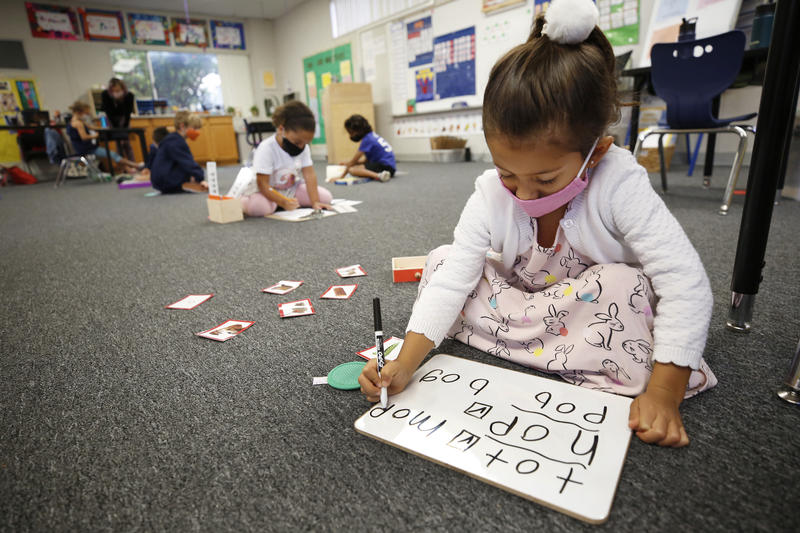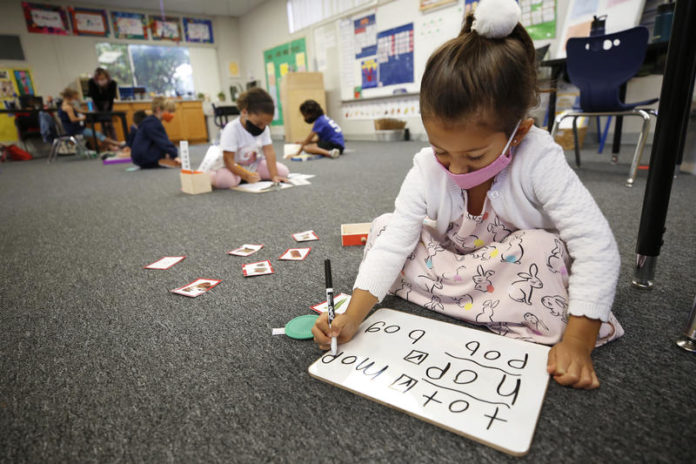Kindergarten students Amelia Ramirez, front, and Naomi Cooney, back, distance themselves while working in the classroom of Kindergarten Teacher Dr. Amanda Hartigan at Chadwick School in Palos Verdes on Nov. 5, 2020.
 Credit: Al Seib/Los Angeles Times/Polaris
Credit: Al Seib/Los Angeles Times/Polaris
Kindergarten students Amelia Ramirez, front, and Naomi Cooney, back, distance themselves while working in the classroom of Kindergarten Teacher Dr. Amanda Hartigan at Chadwick School in Palos Verdes on Nov. 5, 2020.
An estimated 152,000 California children went missing from public school classrooms amid the pandemic, according to new Stanford research, reflecting a period of profound disruption of family and school life.
“Public school enrollment fell dramatically during the first two school years of the COVID-19 pandemic, with losses concentrated among the youngest students,” writes Stanford education professor Thomas Dee in the new report. “But we know little about where these students went and what learning environments they are experiencing.”
A collaboration between Stanford, Big Local News and the Associated Press, the analysis tracked 240,000 unaccounted-for public school students nationwide with the deepest declines in the early grades and in states focused on remote learning. California, the nation’s most populous state, had the highest number of missing students. While the losses were steepest among the youngest learners, they were also significant in grades 6-8, data show.
The study looked at enrollment across three school years, from 2019-20, when the pandemic began, to 2021-22, when schools began to reopen. During that turbulent period, California’s school-age population dropped about 96,000, according to Census data, while the number of homeschoolers increased by 14,100 and private school enrollment grew by 9,500, according to the report. Adding up all those known factors accounts for about 119,500 students of the total decline of 271,000. If you crunch the numbers, that leaves roughly 152,000 students, or 56% of the enrollment decline. Where these students went largely remains a mystery.
“The fact that so much of the loss cannot be explained raises new questions about what will help students get their education back on track,” said Dee, although he notes that some of the dip may be attributable to measurement error involving census data.
Many experts point to families leaving the state in search of greener pastures, particularly more affordable housing amid spiking inflation.
“We have had declining enrollment in California for many years, and it will continue as a trend,” said Scott Moore, head of Kidango, a nonprofit organization that runs many Bay Area child care and preschool centers. “Perhaps the pandemic sped up the trend, with families leaving the state and using the shutdown period as a time to move to more affordable states who reopened their classrooms sooner. The fact that there is historically low unemployment would certainly make it easier for families to move out of state.”
Dee maintains that the study adjusted for this dramatic shrinking in state population and points to other reasons for the dropoff.
“My calculation adjusts for the substantial decline in California’s estimated school-age population during the pandemic,” he said. “To my mind, the candidate explanations are unregistered homeschooling increases, truancy, and California families choosing to skip kindergarten.”
Many families opted to skip or delay kindergarten during the pandemic because remote school was arduous for small children who crave in-person interaction and often zone out with screens. Some families chose to stick with in-person preschools instead of suffering through Zoom kindergarten. Others dove into homeschooling because of Covid fears and stuck with it.
It should be noted that, in California, kindergarten is now a two-year program that includes transitional kindergarten, or TK, an extra year of school that was initially designed for children who just missed the cutoff date for kindergarten, roughly 100,000 students statewide. TK is currently being expanded to reach all 4-year-olds.
At Kidango’s child care and preschool centers, many of the children who were eligible to go into transitional kindergarten during the pandemic opted to stay in preschool instead.
Both TK and kindergarten are optional in California and most other states. Children are only required to attend school once they turn 6 although a movement to make it mandatory has been gaining momentum in recent years.
Some homeschooling families may also have failed to properly notify state officials, experts say, particularly for kindergarten.
“Unexplained public-school enrollment loss could reflect in part an increasing number of kids in homeschool kindergarten rather than public kindergarten,” said Dee.
To be sure, many private schools resumed in-person instruction far more quickly than their public counterparts and homeschooling held extra appeal amid recurring outbreaks.
“Unsurprisingly, the growth in private school enrollment was particularly large in kindergarten and early elementary grades,” Dee notes. “In particular, the large growth in 2021–22 private school enrollment in first grade is consistent with the hypothesis that some of the many families who avoided public kindergarten in 2020–21 instead chose private schools and remained with that choice.”
Escalating chronic absenteeism is also a key factor, Dee said. Last year in Los Angeles, nearly half of the students missed 10% or more of the school year. Clearly many students feel disengaged from school.
“Schools were broken before Covid for a lot of kids,” said Shantel Meek, founding director of the Children’s Equity Project, an advocacy/research organization based at Arizona State University. “Inequities existed in everything, harsh discipline, access to experienced teachers and advanced coursework, physical facilities, access to counselors, but they were keeping more kids than we realized from falling through the cracks. It feels like maybe Covid, and our response to it, widened that crack.”
Certainly, most experts agree the most urgent concern is that lower-income children will be most impacted by pervasive disruptions in schooling.
“Young disadvantaged children are hit the hardest,” said Bruce Fuller, professor of education and public policy at the University of California at Berkeley. “The pressing worry is that it worsens disparities in children’s early learning.”
Some students may have just stopped going to school, Dee fears, suggesting a need for increased oversight of truancy as well as homeschooled children’s learning experiences.
“We worry about the children who miss out on high-quality early education learning experiences,” said Gennie Gorback, president of the California Kindergarten Association. “Even though many first grade teachers support learning through play and developmentally appropriate practices, they also expect children to enter their classroom with a baseline school experience, able to communicate with their peers, and adhere to behavioral expectations.”
However, others note that a shift in thinking about public education may have taken place during the pandemic. In a time of crisis, some families lost faith in the ability of the schools to meet the needs of students.
“We should consider what breaking the social compact did for public education,” said Moore. “For a long time in California, most people were back to work while schools remained closed. Families were not only left in the lurch, they also had plenty of time to ask questions they likely never considered: Is my child happier at home? Is my child safe at school? Can I trust my school to educate and care for my child? Is school worthwhile?”
Certainly, closing the schools remains a hot-button issue for many families. Some say it triggered part of the enrollment decline.
“This is yet another tragic consequence of our statewide and local leaders’ inaction when it came to getting kids back into their classrooms quickly during the pandemic,” said Megan Bacigalupi, co-founder of CA Parent Power, a statewide parent advocacy organization.“Far too many kids, especially high school-age students, just stopped going to class all together and clearly some never came back. When we gave students an hour on Zoom a day, that was showing them that school was not important, what kind of message did that send to them?”
The turbulence wrought by the pandemic may be leading the education world toward a watershed moment, some say, a time to rebuild the critical connection between families and schools.
“My hope is this disruption will lead us to ask bigger questions about our public education system, which is still largely based on a model developed hundreds of years ago,” said Moore. “Public education needs to look in the mirror — not at parents — when it ponders why children left.”
To get more reports like this one, click here to sign up for EdSource’s no-cost daily email on latest developments in education.






